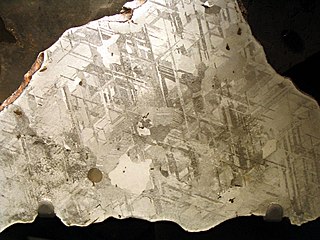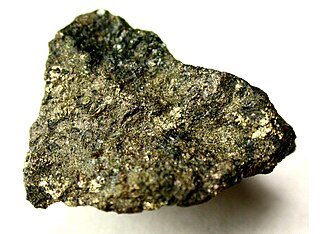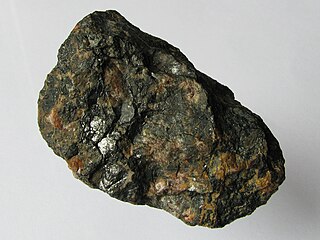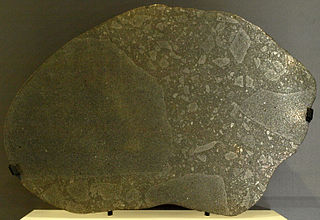
Kamacite is an alloy of iron and nickel, which is found on Earth only in meteorites. According to the International Mineralogical Association (IMA) it is considered a proper nickel-rich variety of the mineral native iron. The proportion iron:nickel is between 90%:10% and 95%:5%; small quantities of other elements, such as cobalt or carbon may also be present. The mineral has a metallic luster, is gray and has no clear cleavage although its crystal structure is isometric-hexoctahedral. Its density is about 8 g/cm3 and its hardness is 4 on the Mohs scale. It is also sometimes called balkeneisen.

Peridot, sometimes called chrysolite, is a yellowish-green transparent variety of olivine. Peridot is one of the few gemstones that occur in only one color.

Pentlandite is an iron–nickel sulfide with the chemical formula (Fe,Ni)9S8. Pentlandite has a narrow variation range in nickel to iron ratios (Ni:Fe), but it is usually described as 1:1. In some cases, this ratio is skewed by the presence of pyrrhotite inclusions. It also contains minor cobalt, usually at low levels as a fraction of weight.

Metamorphism is the transformation of existing rock to rock with a different mineral composition or texture. Metamorphism takes place at temperatures in excess of 150 °C (300 °F), and often also at elevated pressure or in the presence of chemically active fluids, but the rock remains mostly solid during the transformation. Metamorphism is distinct from weathering or diagenesis, which are changes that take place at or just beneath Earth's surface.

A chondrite is a stony (non-metallic) meteorite that has not been modified, by either melting or differentiation of the parent body. They are formed when various types of dust and small grains in the early Solar System accreted to form primitive asteroids. Some such bodies that are captured in the planet's gravity well become the most common type of meteorite by arriving on a trajectory toward the planet's surface. Estimates for their contribution to the total meteorite population vary between 85.7% and 86.2%.

Coffinite is a uranium-bearing silicate mineral with formula: U(SiO4)1−x(OH)4x.

Forsterite (Mg2SiO4; commonly abbreviated as Fo; also known as white olivine) is the magnesium-rich end-member of the olivine solid solution series. It is isomorphous with the iron-rich end-member, fayalite. Forsterite crystallizes in the orthorhombic system (space group Pbnm) with cell parameters a 4.75 Å (0.475 nm), b 10.20 Å (1.020 nm) and c 5.98 Å (0.598 nm).

Sperrylite is a platinum arsenide mineral with the chemical formula PtAs2 and is an opaque metallic tin white mineral which crystallizes in the isometric system with the pyrite group structure. It forms cubic, octahedral or pyritohedral crystals in addition to massive and reniform habits. It has a Mohs hardness of 6–7 and a very high specific gravity of 10.6.

Lawsonite is a hydrous calcium aluminium sorosilicate mineral with formula CaAl2Si2O7(OH)2·H2O. Lawsonite crystallizes in the orthorhombic system in prismatic, often tabular crystals. Crystal twinning is common. It forms transparent to translucent colorless, white, pink, and bluish to pinkish grey glassy to greasy crystals. Refractive indices are nα = 1.665, nβ = 1.672 – 1.676, and nγ = 1.684 – 1.686. It is typically almost colorless in thin section, but some lawsonite is pleochroic from colorless to pale yellow to pale blue, depending on orientation. The mineral has a Mohs hardness of 7.5 and a specific gravity of 3.09. It has perfect cleavage in two directions and a brittle fracture.

Ferrihydrite (Fh) is a widespread hydrous ferric oxyhydroxide mineral at the Earth's surface, and a likely constituent in extraterrestrial materials. It forms in several types of environments, from freshwater to marine systems, aquifers to hydrothermal hot springs and scales, soils, and areas affected by mining. It can be precipitated directly from oxygenated iron-rich aqueous solutions, or by bacteria either as a result of a metabolic activity or passive sorption of dissolved iron followed by nucleation reactions. Ferrihydrite also occurs in the core of the ferritin protein from many living organisms, for the purpose of intra-cellular iron storage.

Ringwoodite is a high-pressure phase of Mg2SiO4 (magnesium silicate) formed at high temperatures and pressures of the Earth's mantle between 525 and 660 km (326 and 410 mi) depth. It may also contain iron and hydrogen. It is polymorphous with the olivine phase forsterite (a magnesium iron silicate).
Jarosewichite is a rare manganese arsenate mineral with formula: Mn2+3Mn3+(AsO4)(OH)6. It was first described in Franklin, New Jersey which is its only reported occurrence. Its chemical composition and structure are similar to chlorophoenicite. This mineral is orthorhombic with 2/m2/m2/m point group. Its crystals are prismatic or barrel-shaped. The color of jarosewichite is dark red to black. It has subvitreous luster of fracture surfaces and reddish-orange streak. This mineral occurs with flinkite, franklinite, andradite and cahnite.

Iddingsite is a microcrystalline rock that is derived from alteration of olivine. It is usually studied as a mineral, and consists of a mixture of remnant olivine, clay minerals, iron oxides, and ferrihydrites. Debates over iddingsite's non-definite crystal structure caused it to be de-listed as an official mineral by the IMA; thus, it is properly referred to as a rock.
Paulingite or paulingite-K is a rare zeolite mineral that is found in vesicles in the basaltic rocks from the Columbia River near Rock Island Dam, Washington.
Stuart Olof Agrell was an optical mineralogist and a pioneer in applications of the electron microprobe to petrology. His involvement as a principal investigator in the analysis of Moon rocks collected in the Apollo program brought him to the attention of the British media and public.

Enstatite chondrites are a rare form of meteorite, rich in the mineral enstatite. Only about 200 E-Type chondrites are currently known, comprising about 2% of the chondrites that fall on Earth. There are two main subtypes: EH and EL, classified based on their iron content.

Khatyrkite is a rare mineral which is mostly composed of copper and aluminium, but may contain up to about 15% of zinc or iron. Its chemical structure is described by an approximate formula (Cu,Zn)Al2 or (Cu,Fe)Al2. It was discovered in 1985 in a placer in association with another rare mineral cupalite. These two minerals have only been found at 62°39′11″N174°30′02″E in the area of the Iomrautvaam, a tributary of the Khatyrka river, in the Koryak Mountains, in Anadyrsky District, Chukotka, Russia. Analysis of one of the samples containing khatyrkite showed that the small rock was from a meteorite. A geological expedition has identified the exact place of the original discovery and found more specimens of the Khatyrka meteorite. The mineral's name derives from the Khatyrka zone where it was discovered. Its type specimen is preserved in the Mining Museum in Saint Petersburg, and parts of it can be found in other museums, such as Museo di Storia Naturale di Firenze.

Coloradoite, also known as mercury telluride (HgTe), is a rare telluride ore associated with metallic deposit. Gold usually occurs within tellurides, such as coloradoite, as a high-finess native metal.

Maricite or marićite is a sodium iron phosphate mineral (NaFe2+PO4), that has two metal cations connected to a phosphate tetrahedron. It is structurally similar to the much more common mineral olivine. Maricite is brittle, usually colorless to gray, and has been found in nodules within shale beds often containing other minerals.
Caswell Silver was an American geologist and entrepreneur who was President of Sundance Oil Company from 1960 to 1984. In addition to the business of oil and gas exploration, he was active in the American Association of Petroleum Geologists and published original research on petroleum geology. He endowed the Caswell Silver Foundation at the University of New Mexico.
















